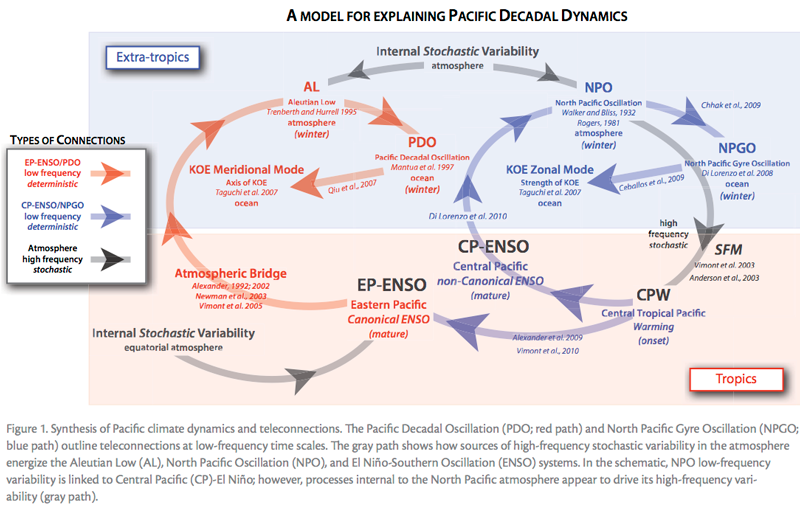Di Lorenzo, E., G. Liguori, J. Furtado, N.
Schneider, B. T. Anderson and M. Alexander, 2015:
ENSO and Meridional Modes: a null hypothesis for Pacific climate
variability.
Geophysical Research Letters, 42, doi:10.1002/2015GL066281. [
PDF ]
Di Lorenzo E., K. M. Cobb, J. Furtado, N.
Schneider, B. T. Anderson, A. Bracco, M. Alexander and D. Vimont, 2010:
Central Pacific Warming El Nino and decadal climate change in
the North Pacific.
Nature Geoscience, 3 (11), 762-765, doi: 10.1038/NGEO984. [ PDF ]
Di Lorenzo E. et al. 2013: Synthesis of Pacific Ocean climate and ecosystem dynamics. Progress of Oceanography, 26(4): 68-81. [ LINK ]
The decadal
dynamics of the Pacific Decadal Oscillation (PDO)
and the North Pacific Gyre Oscillation (NPGO)
are linked through their relationships to ENSO. Based on
these results and previous literature we propose the following synthesis of
Pacific decadal variability (Figure below, schematic):

The PDO and NPGO are the oceanic expression of the two
dominant modes of North Pacific atmospheric variability -- the Aleutian Low
(AL) and the North Pacific Oscillation (NPO), which are linked to the
different phases of the ENSO cycle (Figure above, schematic). Specifically,
the boreal spring variability of the NPO drives SSTa in the central tropical
Pacific that initiate the ENSO expression that peaks in the following winter
[e.g. the Seasonal Footprinting Mechanism (SFM) by Vimont et al., 2003;
Anderson et al. 2003]. The peak of ENSO in the following winter excites
variability in the AL through well known atmospheric teleconnections
[Alexander, 1992; Alexander et al., 2002]. The atmospheric teleconnected
variability of the AL is integrated and low-passed by the ocean into the PDO
pattern [Newman et al., 2003] in the same way as the NPO variability is
integrated into the oceanic NPGO pattern [Chhak et al., 2009].
More recently in Di Lorenzo et al. (2010) these findings have been expanded to account for additional teleconnections from the tropics to the extra-tropics between ENSO and the Pacific decadal modes. We find that dominant decadal fluctuations of the North Pacific sea surface temperatures and gyre-scale circulation of the North Pacific Gyre Oscillation (NPGO), are dynamically linked to the central Pacific warming (CPW) El Niño -- an emerging mode of interannual variability of the tropical Pacific that is different from the canonical EPW ENSO in that the SST maximum anomalies are displaced from the eastern to the central Pacific. We show that the CPW drives low-frequency changes in the extra-tropical atmospheric circulation that are integrated by the ocean to form the decadal NPGO. This new link provides us with an improved conceptual framework of Pacific climate variability that is summarized in the figure below. In this new framework, evidence for more frequent CPW events under greenhouse forcing scenarios is consistent with a more energetic late 20th century NPGO6, implying that NPGO will play an increasingly important role in shaping Pacific climate and marine ecosystems in the 21st century.
The oceanic adjustment to the SSHa anomalies of the PDO and
NPGO radiate Rossby waves that propagate the signals into the
Kuroshio-Oyashio extension region (KOE). The arrival of the PDO SSHa are
associated with changes in the axis of the KOE [Miller and Schneider, 2000;
Qiu et al., 2007], while the NPGO SSHa modulate variations in the speed of
the KOE [Ceballos et al., 2009] (Figure 4). These two modes of KOE
variability, the KOE meridional mode (shift in axis) and the KOE Zonal mode
(change in speed), respectively, have been shown to capture the first two
modes of variability of SSHa in the KOE [Taguchi et al., 2007].
The forcing dynamics of the NPO and its relationship to the
tropics require further investigation. Although there are physically-based
hypotheses that link the NPO forcing to the ENSO dynamics [e.g. the SSTa
footprinting mechanism, Vimont et al., 2003; Meridional Mode (MM), Chiang
and Vimont, 2004; Chang et al., 2007] and to tropical SSTa [Vimont et al.,
2009], the source of NPO variability has so far been attributed to intrinsic
atmospheric variability in the midlatitudes associated with changes in
strength of the storm tracks [Linkin and Nigam, 2008]. However, recent
studies
[Di Lorenzo et al., 2010] suggest that the low-freqiency content of the NPO variability may not be
independent of ENSO and may originate in the equatorial Pacific. If this
link is confirmed (Figure 4, gray path), the schematic framework proposed in
this study may provide the physical basis for sustained oscillations in the
Pacific Ocean. As these dynamics are investigated further in coupled climate
models and observations, it will be essential to quantify the role of
atmospheric noise in interrupting or exciting some of the dynamical pathways
linking the tropics and extra-tropics.
____________________________________
This work is sponsored by the
National Science Foundation and
US GLOBEC Program
through the Physical and Biological Oceanography programs
